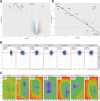Intergenerational trauma is associated with expression alterations in glucocorticoid- and immune-related genes
- PMID: 33173192
- PMCID: PMC8027026
- DOI: 10.1038/s41386-020-00900-8
Intergenerational trauma is associated with expression alterations in glucocorticoid- and immune-related genes
Abstract
Offspring of trauma survivors are more likely to develop PTSD, mood, and anxiety disorders and demonstrate endocrine and molecular alterations compared to controls. This study reports the association between parental Holocaust exposure and genome-wide gene expression in peripheral blood mononuclear cells (PBMC) from 77 Holocaust survivor offspring and 15 comparison subjects. Forty-two differentially expressed genes (DEGs) were identified in association with parental Holocaust exposure (FDR-adjusted p < 0.05); most of these genes were downregulated and co-expressed in a gene network related to immune cell functions. When both parental Holocaust exposure and maternal age at Holocaust exposure shared DEGs, fold changes were in the opposite direction. Similarly, fold changes of shared DEGs associated with maternal PTSD and paternal PTSD were in opposite directions, while fold changes of shared DEGs associated with both maternal and paternal Holocaust exposure or associated with both maternal and paternal age at Holocaust exposure were in the same direction. Moreover, the DEGs associated with parental Holocaust exposure were enriched for glucocorticoid-regulated genes and immune pathways with some of these genes mediating the effects of parental Holocaust exposure on C-reactive protein. The top gene across all analyses was MMP8, encoding the matrix metalloproteinase 8, which is a regulator of innate immunity. To conclude, this study identified a set of glucocorticoid and immune-related genes in association with parental Holocaust exposure with differential effects based on parental exposure-related factors.
Figures




Similar articles
-
Influences of maternal and paternal PTSD on epigenetic regulation of the glucocorticoid receptor gene in Holocaust survivor offspring.Am J Psychiatry. 2014 Aug;171(8):872-880. doi: 10.1176/appi.ajp.2014.13121571. Am J Psychiatry. 2014. PMID: 24832930 Free PMC article.
-
Maternal PTSD associates with greater glucocorticoid sensitivity in offspring of Holocaust survivors.Psychoneuroendocrinology. 2014 Feb;40:213-20. doi: 10.1016/j.psyneuen.2013.11.019. Epub 2013 Dec 1. Psychoneuroendocrinology. 2014. PMID: 24485493 Free PMC article.
-
Elevation of 11β-hydroxysteroid dehydrogenase type 2 activity in Holocaust survivor offspring: evidence for an intergenerational effect of maternal trauma exposure.Psychoneuroendocrinology. 2014 Oct;48:1-10. doi: 10.1016/j.psyneuen.2014.06.001. Epub 2014 Jun 7. Psychoneuroendocrinology. 2014. PMID: 24971590 Free PMC article.
-
[AGING IN THE SHADOW OF INTERGENERATIONAL TRANSMISSION OF TRAUMA: THE CASE OF OFFSPRING OF HOLOCAUST SURVIVORS].Harefuah. 2020 Apr;159(4):282-286. Harefuah. 2020. PMID: 32307969 Review. Hebrew.
-
Intergenerational consequences of the Holocaust on offspring mental health: a systematic review of associated factors and mechanisms.Eur J Psychotraumatol. 2019 Aug 30;10(1):1654065. doi: 10.1080/20008198.2019.1654065. eCollection 2019. Eur J Psychotraumatol. 2019. PMID: 31497262 Free PMC article. Review.
Cited by
-
Intergenerational Postoperative Neurocognitive Disorder in a Rat Model: Initiating Mechanisms and Pharmacological Prevention.Anesthesiology. 2025 Sep 1;143(3):661-679. doi: 10.1097/ALN.0000000000005578. Epub 2025 May 23. Anesthesiology. 2025. PMID: 40408187
-
Intergenerational Perioperative Neurocognitive Disorder.Biology (Basel). 2023 Apr 7;12(4):567. doi: 10.3390/biology12040567. Biology (Basel). 2023. PMID: 37106766 Free PMC article. Review.
-
Towards precision medicine for anxiety disorders: objective assessment, risk prediction, pharmacogenomics, and repurposed drugs.Mol Psychiatry. 2023 Jul;28(7):2894-2912. doi: 10.1038/s41380-023-01998-0. Epub 2023 Mar 7. Mol Psychiatry. 2023. PMID: 36878964 Free PMC article.
-
Epigenetic Echoes: Bridging Nature, Nurture, and Healing Across Generations.Int J Mol Sci. 2025 Mar 27;26(7):3075. doi: 10.3390/ijms26073075. Int J Mol Sci. 2025. PMID: 40243774 Free PMC article. Review.
-
Inflammation in Posttraumatic Stress Disorder: Dysregulation or Recalibration?Curr Neuropharmacol. 2024;22(4):524-542. doi: 10.2174/1570159X21666230807152051. Curr Neuropharmacol. 2024. PMID: 37550908 Free PMC article.
References
-
- Yahyavi ST, Zarghami M, Marwah U. A review on the evidence of transgenerational transmission of posttraumatic stress disorder vulnerability. Braz J Psychiatry. 2014;36:89–94. - PubMed
-
- Field NP, Muong S, Sochanvimean V. Parental styles in the intergenerational transmission of trauma stemming from the Khmer Rouge regime in Cambodia. Am J Orthopsychiatry. 2013;83:483–94. - PubMed
-
- Shmotkin D, Shrira A, Goldberg S, Palgi Y. Resilience and vulnerability among aging holocaust survivors and their families: an intergenerational overview. J Intergeneration Relationsh. 2011;9:7–21.
Publication types
MeSH terms
Substances
Grants and funding
LinkOut - more resources
Full Text Sources
Medical
Research Materials

